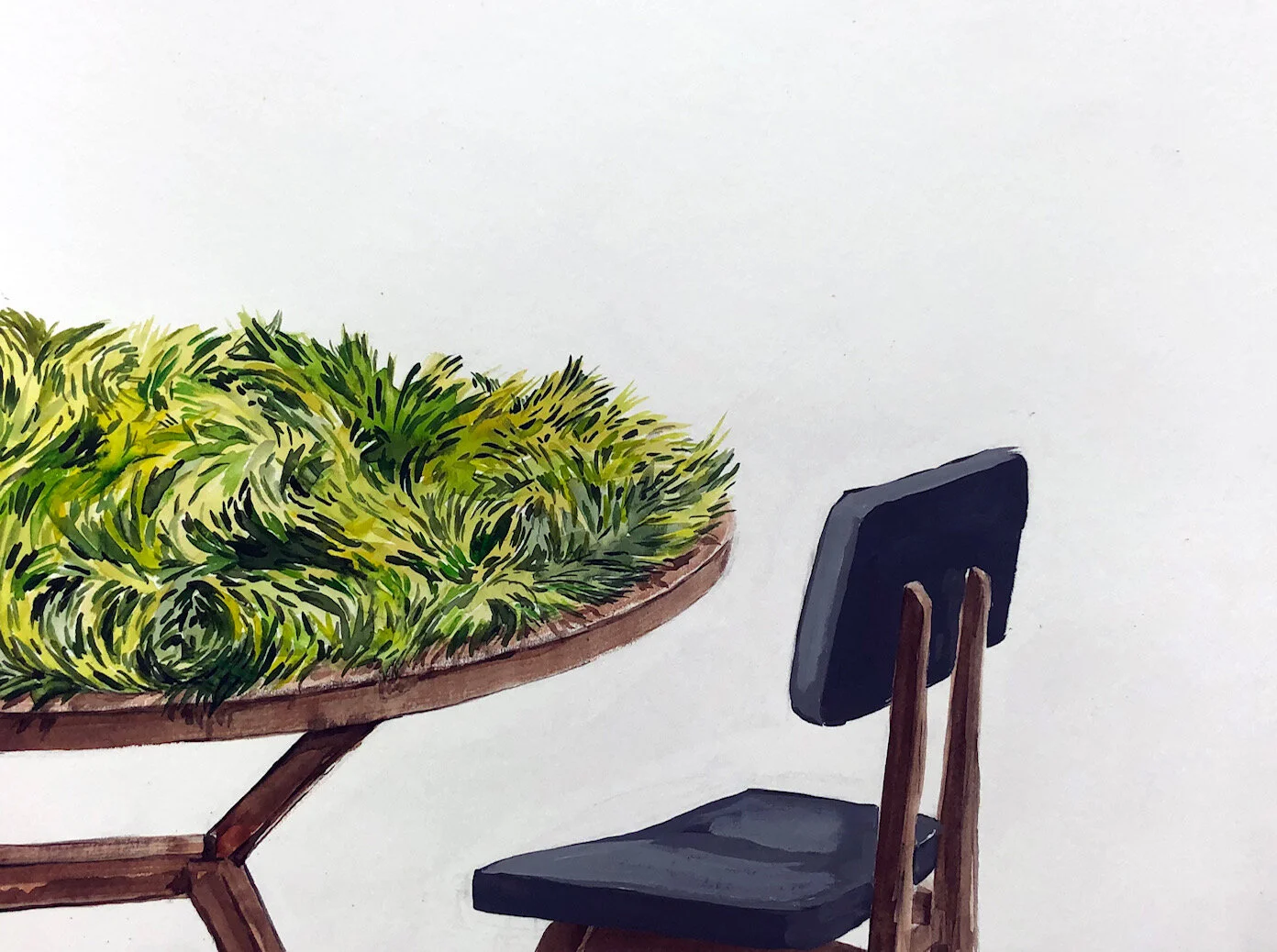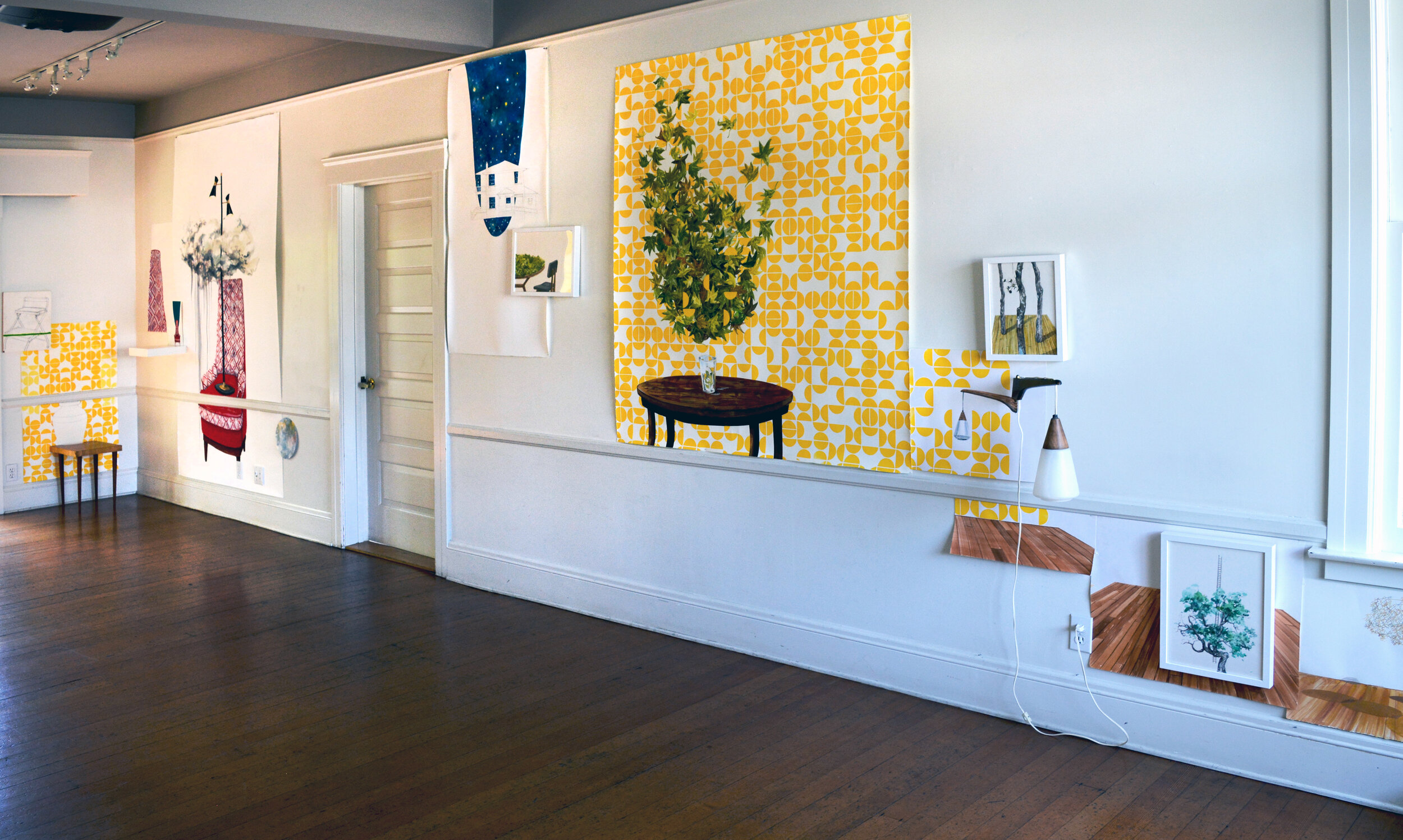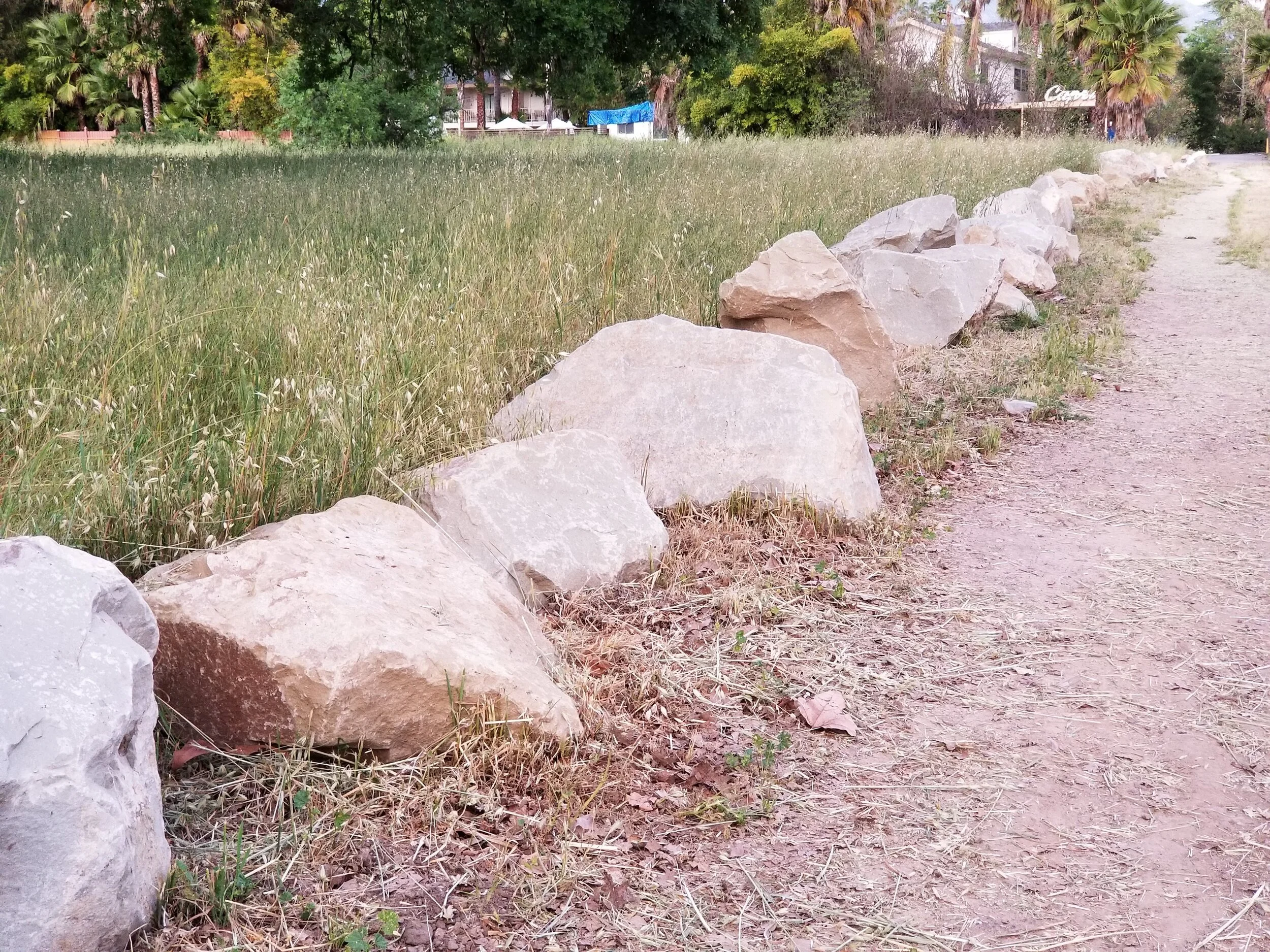Nathan Huff: Meandering the Edges at Architectural Foundation
In Conversation: Nathan Huff and Bay Hallowell
Meandering the Edges, an art installation by Nathan Huff at the Architectural Foundation of Santa Barbara, was scheduled to open on March 13, 2020. Due to Covid-19, the opening reception was cancelled and only a handful of people have seen it.
Huff’s installation examines ways in which we inhabit homes and move through domestic spaces based on memory and emotion. Installed in unconventional ways on the walls, floor and corners of the gallery space, his paintings on paper depicting furniture, wood floors, tables and shovels engage with the space itself—the historic, Victorian Italianate style home designed and built in 1904 by James J. Acheson.
The Acheson House was a residence prior to hosting the offices of several non-profit organizations including the Architectural Foundation, the Santa Barbara Chapter of the AIA, and the Junior League of Santa Barbara. Huff’s poetic images and sculpture include a range of surrealistic and trompe l’oeil styles and installation techniques. Gliding between the almost comprehensible to the absurd, the works provoke reflections and emotions that resonate with the current quarantine.
Nathan Huff, “Sunlight Settle Sycamore,” Meandering the Edges, Architectural Foundation of Santa Barbara, 2020.
Bay Hallowell: You have totally transformed the intimate gallery/meeting space of the Architectural Foundation. What inspired you?
Nathan Huff: I’m glad to hear that it feels unique to you. It was indeed my hope to offer a fresh engagement to a familiar place. When I prepare to make art for a gallery, I often reflect on questions such as: What assumptions do I have about this place? What are some of its perceived limitations? Are they real or self-imposed? In the Architectural Foundation gallery, I noticed that due to the chair rail (a strip of molding that runs the perimeter of the room and protects the backs of chairs from making scuffs on the walls), I was limited to the scale of paintings that I could exhibit.
Rather than being dissuaded by this height restriction, I decided to embrace it and use the chair rail as the primary driver of the show. Using a construction limitation as the design key for the show allowed me to play with hanging art in new ways. Since I now planned to rupture the traditional wall space, I was free to essentially hang art anywhere—in a corner, under a stair or across the chair rail itself.
This meandering of the edges provided great freedom and extended a sense of play that I found exciting.
Nathan Huff, Installation view, Meandering the Edges, Architectural Foundation of Santa Barbara, 2020.
Unlike some of your previous installations, Meandering the Edges responds in rather specific yet veiled ways to the history of the site, the Acheson House, a Victorian Italianate home built in 1904. How did this particular building affect your thinking and creative process?
I was excited to research the particularities of the Acheson Home. The home’s prominence as an architectural marker and exemplary style in Santa Barbara was inspiring. Unfortunately, when I looked into the building’s oral and written history, I found very little background about the original owners of the home and very few known narrative stories to use as content inspiration. Initially, I found this disappointing, but it also allowed me to overlay and invent an investigation of the home from a more personal or fictionalized account.
Using the home’s floor plan drawings, I made a series of studies that didn’t make it into the show but that helped me think about what types of narratives I might draw out of the space. Ultimately, I looked for commonalities of domestic life such as seating places, lighting, decoration, landscaping and spatial use to engage with the building’s imagined history.
Nathan Huff, Detail, Meandering the Edges, Architectural Foundation of Santa Barbara, 2020.
Nathan Huff, Installation view, Meandering the Edges, Architectural Foundation of Santa Barbara, 2020.
I see a large painting (it covers an entire wall!) depicting assorted shovels, spades, pitchforks, hoes, several garden trowels and even a post hole digger, all seemingly suspended in space. Standing tall like sentinels on nothing at all, these tools summon questions: Who dug the foundations of this house? Who tended the garden and built the fences? They’re leisurely, dream-like musings on the human life these walls and doors and windows have witnessed over the years. Juxtaposed as they are with a dark patch of starry night sky and several cut-out planets, I feel catapulted from ordinary, everyday life into the immensity and eternal grandeur of the universe.
I’m so happy you found those connections. I love examining familiar objects. Pulling them out of their natural context and inviting us to look at them within a blank tableau offers viewers opportunities to ask questions. For me, hand tools have always been a metaphorical bridge between the virgin earth and the built home. Excavation and preparation: these are required before building a home and they are precursors to artmaking. The starry skies often stand in as a reminder of the grandeur of the cosmos even as we eke out our existence in little corners of this earth.
The interplay between feeling oneself to be both indoors and outside is delightful. I spied a swath of Astroturf in one corner and a painted fireplace in another. Also, a drawing of the exterior of the Acheson House placed atop a starry night painting, near yellow and white wallpaper with a geometric design. There is a painting of tousled grass nonchalantly growing on a wooden table. How consciously were you contrasting indoors and outdoors?
Domestic spaces and untamed nature have been a source of interest for me for some time. Juxtaposing the seemingly cultivated and safe spaces of the interior with wild natural elements requires a conceptual stretch on the part of the viewer. I like mental spaces that embrace and expand rather than reduce or constrict the imagination.
Nathan Huff, “Climbing,” Meandering the Edges, Architectural Foundation of Santa Barbara, 2020.
Visual echoes abound! Real steps leading upstairs at the back of the gallery are in dialogue with a stack of wood squares placed like steps at the front of the gallery. The two semi-circular forms created by cutting a white utility bucket in half vertically are repeated in the wallpaper. A hanging wall lamp is mirrored in a small painting of the same lamp. There are two identical, conjoined, ceramic mugs. How does all this happen?
My studio process is quite cyclical. I usually make at least double and often triple the amount of work that I anticipate using in an exhibition. When I am inspired by an idea or image, I often follow a thread of exploration by creating multiple works in a variety of media that circle back around on themselves. I spend a good deal of time editing and arranging 2D and 3D elements to build a coherent and interesting visual experience. I often describe the work of creating an exhibition as similar to composing a visual poem. When unique visual phrases connect to other parts of the poem, the outcome invites associative connections rather than a linear narrative.
Past and present. A classic example of domestic architecture from the dawn of the 20th century is now filled with mid-century furniture and deftly painted realistic images to create a surreal setting for the 21st century. The delicate clock hands placed at one corner of a casually stacked wood square are ticking… How does a sense of time and eternity play out in your work?
Suspension is a recurrent obsession in my work. At its core, my artistic practice centers around suspending a moment, holding an object or idea aloft and trying to study it from various perspectives. I hope to find ways to pause and more deeply reflect on a few things in my life before it is over. Enjoying the texture of a wooden floorboard, re-examining the design trends of wallpaper from another time, thinking about seating arrangements in our homes—these all allow us to gather meaning through pausing and to inadvertently discover things about ourselves. When time frames collide, we can begin to examine the complex connections and contradictions that reside within ourselves.
You mentioned “narrative potential.” There are the stories we tell ourselves and there are iconic stories like “The Tell-Tale Heart” by Edgar Allen Poe, which sprang into my mind when I contemplated your paintings of the wooden floorboards. What stories were percolating in your conscious mind when you created this?
Ideas about shifting memories were at the forefront of this show’s exploration. I am fascinated by the ways that we remember or misremember our own histories. When two people are recalling a shared experience, it’s as if they are doing it from slightly different plateaus - as if the floorboards have shifted. Perhaps the memory of a vase that is so vivid for one person is like a ghostly pencil sketch in another person’s memory. I think for this show, I was exploring the slightly melancholy experience of personal quiet corners and interior reflections.
I recall your interest in Carl Jung’s work. For me, this installation touches on Jungian concepts such as the collective unconscious, alchemy and spirituality. Here, you beckon us into worlds both visible and invisible with your highly original, visual vocabulary and language. In a sense, we have all lived in this house that is uniquely yours. Is Jung’s work related to this installation?
I would be honored if viewers found connections to Jung’s work. I do think often of collective unconscious and spirituality in my art. Jung’s concept of shadow work—encountering and integrating self, seems very much like studio activity to me. In the studio, I seek to integrate disparate images from multiple spheres of life and knowledge. Some of these references pull from the embodiment of simple movement, reflections on spirituality, and the utilization of imagery from varied public and private spaces. Seeing an exhibition of Carl Jung’s Red Book at UC Santa Barbara last year was wonderfully inspiring, especially observing how making marks and images can be a form of self-knowledge. For this exhibition, I was more directly influenced by The Poetics of Space by Gaston Bachelard, Yi Fu Tan’s Space and Place, and Lucy Lippard’s wonderful text, The Lure of the Local.
How do you think about this exhibition now that the context of our shared life has changed due to the Covid-19 pandemic?
I am grateful for the opportunity to have this exhibit up right now. It is a strange experience to present an installation that is meant to be walked through and yet viewers are not allowed to be there. It is a good challenge to figure out other ways to present the work through imposed distance.
The content of the show also feels resonant with what we are carrying collectively right now. As we hunker down in our homes and face uncertainty, we have time for reflection. Much like my installation at the Architectural Foundation, this season represents distance, a longing for connection, a celebration of objects that hold memories, and a shifting of the perceived boundaries of our lives. For me, I am reminded to be present to the joys and sadness of my life at this time. Meandering the Edges is a visual poem for the rich and layered dynamics in my own home and a longing stretch to those places and people who are just out of reach.
Images are from the exhibition, Meandering the Edges, at the Architectural Foundation of Santa Barbara. Copyright 2020.
Bay Hallowell is an artist, curator and gallery committee chairperson at the Architectural Foundation. bayhallowell.com
Nathan Huff is an artist and associate professor of art at Westmont College. nathanhuff.com










